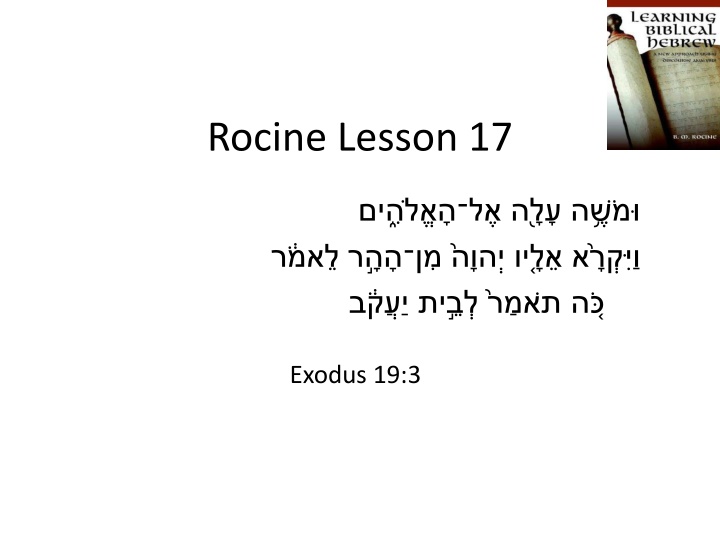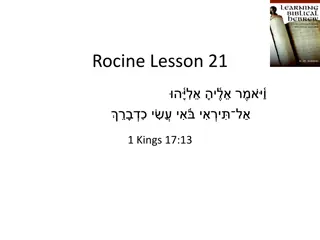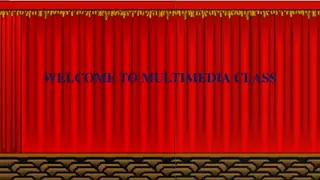Rocine Lesson 17
Importance of the waw-consecutive (also known as vav-consecutive) in Hebrew narrative, distinguishing between different verb forms and genres. Learn how to identify and read speech introduction formulas and Qal yiqtol and wayyiqtol. Examples from Genesis and Exodus provide insights into historical narrative and instructional discourse.
Download Presentation

Please find below an Image/Link to download the presentation.
The content on the website is provided AS IS for your information and personal use only. It may not be sold, licensed, or shared on other websites without obtaining consent from the author.If you encounter any issues during the download, it is possible that the publisher has removed the file from their server.
You are allowed to download the files provided on this website for personal or commercial use, subject to the condition that they are used lawfully. All files are the property of their respective owners.
The content on the website is provided AS IS for your information and personal use only. It may not be sold, licensed, or shared on other websites without obtaining consent from the author.
E N D
Presentation Transcript
Rocine Lesson 17 Exodus 19:3
Goals Distinguish vav-consecutive vav-conjunctive (or vav-disjunctive) Identify and read speech introduction formula Identify and read Qal yiqtol and wayyiqtol (full paradigms)
Vav-consecutive What is the waw-consecutive? Note that I m going to start with different examples than Rocine (p. 92-93) does. Note also that some people write vav and some write waw but they both refer to the same thing.
Vav-consecutive What is the waw-consecutive? 1. In Historical Narrative the waw-consecutive is the waw on the wayyiqtol.
Vav-consecutive What is the waw-consecutive? 1. In Historical Narrative the waw-consecutive is the waw on the wayyiqtol. 2. In the +projection or forward-looking genres found in Direct Speech, (i.e. Predictive Narrative, Instructional Discourse, and Hortatory Discourse), the waw-consecutive is the waw on the weqatal that starts each clause.
Vav-consecutive In other words waw-consecutive is always found on the mainline verb form 1. Wayyiqtol Historical Narrative 2. Weqatal forward-looking genres
Vav-consecutive Example: Waw-consecutive in H. N. Genesis 22:3 And he got up early And he saddled And he took And he split And he arose And he went
Vav-consecutive Example: Waw-consecutive in Instructional Discourse Exodus 12:6 8 And it shall be a charge to you until the 14 day of this month And all the assembly of the congregation of Israel shall slaughter it at twilight And they shall take some of its blood And they shall place it on the two doorposts and on the lintel on the houses in which they will eat it And shall eat the meat on this night roasted by fire
Vav-consecutive Example: Waw-consecutive in Instructional Discourse Exodus 12:6 8 And it shall be a charge to you until the 14 day of this month And all the assembly of the congregation of Israel shall slaughter it at twilight This is a waw-conjunctive And they shall take some of its blood And they shall place it on the two doorposts and on the lintel on the houses in which they will eat it And shall eat the meat on this night roasted by fire
Conjunctive vav versus vav-consecutive Waw-conjunctive Waw-consecutive RULE: The vav s which are part of the mainline verb forms are called vav-consecutive. The vav-consecutive means and, but and also has the special discourse function of linking together the string of events which make up the mainline of a discourse. The vav-consecutive indicates that the action of the verb is the consequence of the preceding situation.
Conjunctive vav versus vav-consecutive Waw-conjunctive Waw-consecutive RULE: Conjunctive (or disjunctive) vav may be attached to almost any word, including a verb form, and means and, but like the vav-consecutive, but it does not have the additional function of stringing together actions in a sequence. We call this vav conjunctive when its clause adds depictive or explanatory material to the mainline and it is best translated and. We call it disjunctive when its clause is used for contrastive purposes, and it is best translated but.
Conjunctive vav versus vav-consecutive Waw-conjunctive Waw-consecutive The discourse function (of linking together the string of events) of the vav-consecutive is the reason why we often translate it with the additional word then or so. You will see later that it may be appropriate to translate the vav-consecutive with the word consequently.
Do you recognize the root? Do you recognize the significance of the holem after the second root letter?
Do you recognize the root? Do you recognize the significance of the holem after the second root letter? to say Indicates infinitive construct
means (literally) to say but it s not usually translated It is used to introduce direct speech View it as opening quotation marks
Yiqtol Memorize the Qal Yiqtol paradigm for the strong verb (Rocine p. 95 and next slide) Pay special attention to the prefixes and complements i.e. the bits added to the root. (See Rocine p. 95 for a chart) Read the other paradigms and explanations on Rocine pages 95-96 but don t memorize the paradigms. Use them to start to become familiar with the changes that occur in weak verbs. Later we ll look at principal parts. For now use these pages to decode the Hebrew in your assignments.
Qal Yiqtol (STRONG verb) Singular Plural 3ms 3mp 3fs 3fp 2ms 2mp 2fs 2fp 1cs 1cp See animated hebrew lectures chapter 17 for a detailed explanation.























